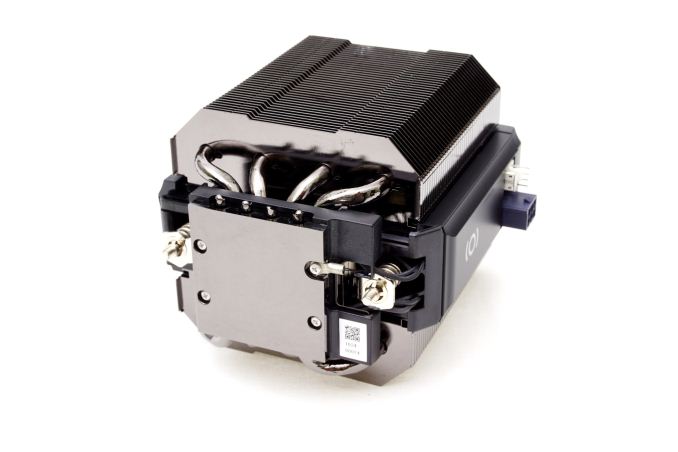The Phononic HEX 2.0 TEC CPU Cooler Review
by E. Fylladitakis on September 26, 2016 9:30 AM EST- Posted in
- Cases/Cooling/PSUs
- Cooler
- TEC
- Phononic
- HEX 2.0
Conclusion
In this review we had a look at perhaps the only consumer CPU thermoelectric-based cooler that has been released after 2010. While Phononic has extensive knowledge and experience on various cooling and refrigeration topics, this is their first retail product aimed at household consumers. The use of a TEC to support the performance of a typical air cooler is not a new concept but Phononic has managed to offer an electronically controlled product that is both simple and safe to use right out of the box.
The most distinct advantage of the Phononic HEX 2.0 is its size. The 12.5 cm tall cooler can easily fit in narrow cases, even some Mini-ITX and desktop designs. When space is an issue and neither large air or liquid coolers are an option, the Phononic HEX 2.0 can provide very good thermal performance on a modern CPU. However, do note that the TEC of the HEX 2.0 will insert additional thermal losses into the case. We do not recommend using it with a case that has very limited cooling capabilities.
The thermal performance of the HEX 2.0 is a complicated matter. The presence of the TEC allows the HEX 2.0 to provide exceptional performance when having to deal with low thermal loads, but the performance degrades as the thermal load increases. For very high thermal loads, the HEX 2.0 is equivalent or worse than an advanced air cooler, hardly justifying its price and energy consumption. That being said, while the HEX 2.0 is good for low temperatures in low power environments, it does add another 20W to the power consumption, perhaps negating the point of a low power system. It should work wonders if installed on a modern energy-efficient CPU, even with some moderate overclocking, but it cannot compare against top-tier air coolers and liquid coolers for advanced overclocking. Bluntly put, if thermal performance is your primary concern and space is not an issue, this is not a product for you.
In summary, the Phononic HEX 2.0 is a very interesting product but it is clearly aimed at a very specific segment of the market, which is users that have serious space limitations and or cannot use liquid cooling solutions for any given reason. If large air coolers or liquid coolers can fit, it is highly unlikely that the HEX 2.0 will have any distinct advantage, let alone justify its $150 retail price.












48 Comments
View All Comments
DanNeely - Monday, September 26, 2016 - link
Do they have an plans to make a 120/140mm version and a larger TEC? The way this struggles above relatively low loads makes it a bust for the OC crowd who might otherwise be tempted to buy it.zepi - Monday, September 26, 2016 - link
Indeed, would be interesting to see this being bundled with NH-D15 level cooler.LordConrad - Tuesday, September 27, 2016 - link
I would also like to see the TEC with a better air cooler attached.saratoga4 - Monday, September 26, 2016 - link
Or one integrated into a watercooling setup. The main problem is that the TEC COP of performance is something like 1.0 to 1.5 watt of cooling per 1 watt of energy spent on the TEC, so you end up needing 1.5-2.0 watts of radiator for every watt of CPU heat generated. A dual 120 radiator ought to handle that easily.MrSpadge - Tuesday, September 27, 2016 - link
Chilled water with a phase change (refrigerator) cooler is way more efficient.JesseKramer - Wednesday, September 28, 2016 - link
Packaging would be more of an issue though I would think.There is lots of infrastructure set up around radiators inside cases.
Adding a TEC into an AIO could be a very interesting product
Lolimaster - Monday, September 26, 2016 - link
Nothing beast using air cooler and undervolting your cpu and maybe drop 100-300Mhz to maximize the gain. Do you really notice the tiny extra performance of OC while wasting tons of watts and heat?damianrobertjones - Monday, September 26, 2016 - link
Yes! I, as a child, often heard scary stories of the 'Nothing Beast'!AndrewJacksonZA - Monday, September 26, 2016 - link
*chuckle*Death666Angel - Tuesday, September 27, 2016 - link
I do. Running my 4770k @ ~3.4GHz like you suggest vs. the 4.5GHz it currently runs at would not save much energy on normal tasks (I OC with an adaptive offset, so 800MHz use ~ 0.71V). Even in many modern games (The Witcher 3, Battlefield 4), I would get lower FPS with such a CPU clock and my R9 290X, which is more CPU dependant than typical Nvidia graphics cards. And doing video encoding of my Blu Ray rips would be painfully slow, scaling nearly linearly with clockspeed. The ~50 to 90W I spend more on intensive tasks is worth it for me, since I can saturate 110FPS with my monitor @ 110Hz and save time during encoding (which make total power consumption per rip not as bad as it would seem).